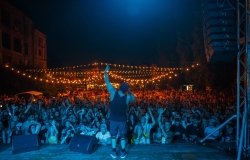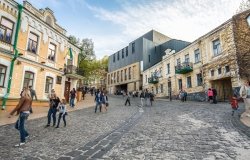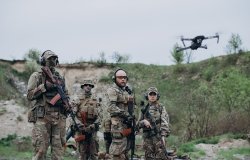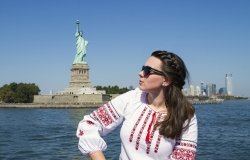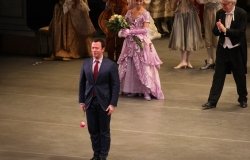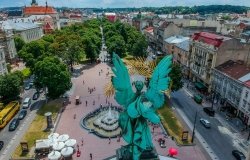
A blog of the Kennan Institute
Revitalizing the City through Sticky Culture at a Time of War

Lviv gained an impressive contemporary art hub last December, despite the ongoing war with Russia. After nearly a decade of planning and construction, the Jam Factory Art Center opened at a former food processing plant in a run-down industrial neighborhood about a mile and a half from the city’s Opera House. It immediately became the city’s largest cultural and artistic center.
The brainchild of Swiss historian and philanthropist Harald Binder, the center has been designed both as a showcase for contemporary art and as a focal point for community cultural life. Comprised of exhibition halls, lecture rooms, a musical space, and public areas open to those living nearby, the Jam Factory is intended to act as a catalyst for neighborhood economic revitalization.
Housed on a neo-Gothic industrial campus dating back as far as 1826—although most buildings were built in the late 19th century—the stunning rehabilitation serves as a catalyst for community activities. As Executive Director Bozhena Pelenska explained at the opening, “In the conditions of war, we have completed a comprehensive revitalization, expanded the team, and prepared an important exhibition and a broad public program. Despite the war and numerous obstacles, we are reaching this long-awaited moment and collectively writing a new chapter in Ukrainian art history.”
The center’s initial exhibition, “Our Years, Our Words, Our Losses, Our Searches, Our Us,” presents works by Ukrainian artists over a century and a half, explicitly highlighting connections between past and present. More than 70 artists—including Alevtina Kakhidze, John Object, Zhanna Kadyrova, Oleksiy Sai, Piotr Armianovski, Nikitia Kadan, Sasha Maslov, and Vlada Ralko—provided images exploring how the war, beginning in 2014, has reshaped society and relationships in profound ways.
Among these works are Elena Subach’s “Tuesday, 2023,” recording the wrapping and storage of public art around the city for safekeeping during Russian air attacks; Yaroslav Futymskyi’s photographic triptych catching images of random passersby the morning of Russia’s February 2022, full-scale invasion; and Anton Saenjo’s powerful photographs of the everyday wartime routines of his fellow citizens. These images find melancholy resonance with Taras Shevchenkoi’s drawings “Fire in the Steppe” from 1848–1849. In addition, Crimean native Yuri Yefanov’s “Cube” offers a video of a concrete box standing on the coast near the Artek children’s camp as a reminder of what he lost with the Russian annexation of Crimea a decade ago.
Volunteers from the Livyy Bereh (Left Bank) initiative provided the exhibition’s largest work: “Theater of Hopes and Expectations.” They reconstructed the family home of a Kyiv family which was destroyed by a Russian rocket during the invasion’s early weeks. The wood came from a city park in Germany and symbolizes society’s postwar rebirth.
The Jam Factory represents the arrival in Ukraine of dreams and ideas derived from European experiences linking urban revitalization and artistic invention. Cultural entrepreneur Binder has long been active in Lviv, with this project representing an extension of his previous initiatives. In 2004, for example, he led the establishment of the renowned Center for Urban History of East Central Europe. Housed in a renovated Art Nouveau period town house designed by Ukrainian architect Ivan Levynskyi, the center has become a respected partner in international research projects, conferences, and publishing ventures.
Like the Jam Factory, the Center for Urban History combines Binder’s interests in the built and cultural urban ecosystems. As Binder told ArtDependence Magazine in late December, “We don’t want to be perceived as a museum or an exhibition hall. We want to be space for meeting, learning, discussing, and sharing experiences.”
Imagined before this war started, delayed by both the coronavirus pandemic and invasion, the Jam Factory has shaped its mission in response to the ongoing upheavals faced by Lvivians and Ukrainians. Binder’s and Pelenska’s vision of mobilizing culture to revitalize urban life confirms community spirit at a time when resilience rarely has been so important.
The opinions expressed in this article are those solely of the author and do not reflect the views of the Kennan Institute.
See our newest content first.
Subscribe to receive the latest analysis from Focus Ukraine
About the Author

Blair A. Ruble
Former Wilson Center Vice President for Programs (2014-2017); Director of the Comparative Urban Studies Program/Urban Sustainability Laboratory (1992-2017); Director of the Kennan Institute for Advanced Russian Studies (1989-2012) and Director of the Program on Global Sustainability and Resilience (2012-2014)

Kennan Institute
The Kennan Institute is the premier US center for advanced research on Eurasia and the oldest and largest regional program at the Woodrow Wilson International Center for Scholars. The Kennan Institute is committed to improving American understanding of Russia, Ukraine, Central Asia, the South Caucasus, and the surrounding region though research and exchange. Read more

